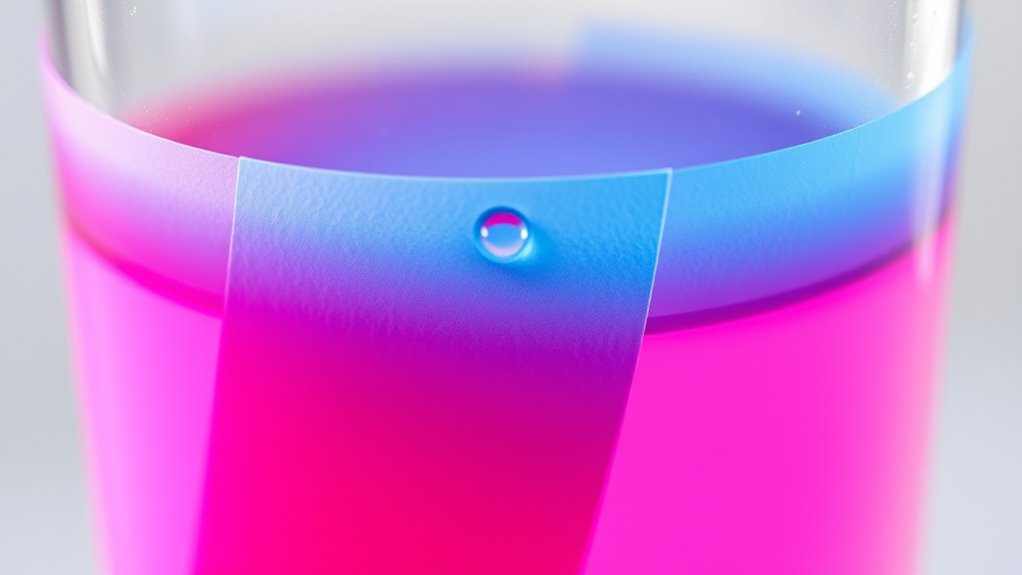pH indicators like litmus paper work because they respond to hydrogen ion concentrations in solutions. They are weak acids or bases that exist in color-changing equilibrium between protonated and deprotonated forms. When pH changes, it shifts this balance, causing a structural change in the molecules that absorbs different light wavelengths. This results in a visible color shift. To understand these fascinating chemical reactions more deeply, explore how their structures influence their color changes.
Key Takeaways
- pH indicators are weak acids or bases that change color depending on their protonation state.
- They exist in equilibrium between protonated (HInd) and deprotonated (Ind-) forms, influenced by hydrogen ion concentration.
- The color shift occurs because protonation alters the molecule’s electronic structure, affecting light absorption.
- The transition range is centered around the indicator’s pKa, typically spanning about two pH units.
- When placed in a solution, the indicator’s color reflects whether the solution is acidic or basic based on the dominant form.
What Are Ph Indicators and How Are They Structured?

pH indicators are chemical compounds that change color depending on the acidity or basicity of a solution. They’re halochromic substances, meaning they respond to hydrogen ion (H+) or hydronium ion (H3O+) concentrations. Typically, these indicators are weak acids or bases that exist in two forms: protonated (HInd) and deprotonated (Ind-). Their structure usually includes conjugated systems or aromatic rings, which allow them to absorb and emit light differently when their electronic structure changes. Functional groups like hydroxyls or amines influence their acid-base behavior and color shift. These organic molecules undergo structural changes upon gaining or losing protons, shifting their absorption spectra. The color change occurs because of alterations in their electronic configuration, which affects how they absorb visible light. This enables the visible color change that makes pH indicators useful for quick, visual pH assessment.
The Chemical Equilibria Behind Indicator Color Changes

The color changes in pH indicators result from shifts in chemical equilibrium between their protonated and deprotonated forms. These weak acids exist in a balance, with each form displaying a different color. When you add an acid or base, the hydrogen ion concentration changes, pushing the equilibrium toward either the protonated or deprotonated form. In acidic solutions, the equilibrium favors the protonated form, often giving one color, while in basic solutions, it shifts toward the deprotonated form, producing another. This shift impacts the indicator’s molecular structure, altering its light absorption properties. The result is an instant visual cue for pH change, as the indicator’s color directly reflects the pH-dependent equilibrium between its two forms, driven by hydrogen ion concentration.
How Ph Affects the Balance of Indicator Forms

As the hydrogen ion concentration in a solution changes, it directly shifts the equilibrium between an indicator’s protonated and deprotonated forms.
When pH is low (acidic), the indicator mostly exists in its protonated, acid form, which has a specific color.
When pH rises (becomes basic), the equilibrium favors the deprotonated, base form, producing a different color.
This shift occurs because the number of H⁺ ions influences the balance, in accordance with Le Chatelier’s principle.
Each indicator has a characteristic pH range where this transition occurs, from one color to another.
Outside this range, the indicator remains in a single form and color.
The continuous change in protonation states causes the visual color change used to estimate pH.
Understanding these properties helps explain how litmus paper effectively indicates pH changes across different solutions.
The Role of Pka in Determining Indicator Transition Ranges

Understanding how pKa influences the behavior of pH indicators helps you predict when they’ll change color. The pKa is the pH at which the acid and base forms of the indicator are present in equal amounts, marking the midpoint of its *shift* range.
Typically, this range spans about two pH units, from (pKa – 1) to (pKa + 1). Below this range, the indicator exists mainly in its acid form with a specific color; above it, in its base form with a different hue.
During the changeover the ratio of acid to base shifts gradually, causing a smooth color change. This behavior enables you to estimate pH visually, as the indicator’s color reflects the equilibrium point dictated by its pKa.
Visual Changes: How Structural Shifts Impact Color

Structural shifts within a pH indicator directly alter its electronic properties, leading to noticeable color changes. When the molecule gains or loses a proton, its conjugated system and electron distribution change, affecting how it absorbs and reflects light. These structural changes are influenced by the specific beneficial ingredients present in the indicator, which can enhance or modify the color transition. The acidic form (HIn) and the deprotonated form (In⁻) have distinct resonance structures, shifting the energy gaps for electronic transitions. These structural rearrangements modify the wavelengths of light absorbed, which determines the color you see. For example, adding or removing protons from groups like hydroxyl or amino impacts the chromophore, causing a transition in hue. As pH varies, the equilibrium between forms shifts gradually, producing a smooth and predictable color change that signals the solution’s acidity or alkalinity.
Examples of Common Indicators and Their Ph Ranges

Have you ever wondered how different pH indicators signal specific acidity or alkalinity levels? Each indicator changes color within a particular pH range, making it easy to identify whether a solution is acidic, neutral, or basic. Understanding digital literacy is also essential in today’s tech-driven world, as it helps users interpret and utilize these indicators effectively. For example, methyl orange shifts from red to yellow between pH 3.1 and 4.4, indicating weak acids and bases. Bromophenol blue transitions from yellow to blue-violet from pH 3.0 to 4.6. Bromocresol green changes from yellow to green-blue between pH 3.8 and 5.4. Phenol red turns from yellow to red between pH 6.8 and 8.2, suitable for neutral to slightly basic solutions. These indicators help you quickly determine pH levels and understand the solution’s chemical nature.
Practical Applications of Ph Indicators in Various Fields

pH indicators play an essential role across many industries by providing quick and reliable measurements of acidity or alkalinity.
In chemical manufacturing, you use them to monitor reactions, guaranteeing ideal conditions and maximizing yields.
In soap production, pH indicators guarantee product safety and consistency.
Pharmaceuticals depend on accurate pH readings during drug formulation to maintain stability and effectiveness.
Wastewater treatment relies on pH indicators to balance water quality before environmental discharge.
Cosmetics companies use them to keep skincare products within safe pH ranges, preventing irritation.
In food and beverage industries, pH indicators monitor fermentation in wine and beer, ensure dairy quality, and stabilize processed foods.
They also help farmers manage soil pH, optimizing crop growth and environmental health.
Additionally, pH indicators are useful for calibrating measurement tools, ensuring precise and consistent readings across various applications.
Limitations and Enhancements for Accurate Ph Measurement

While pH indicators and meters are widely used across industries, their accuracy can be compromised by several limitations. You might find pH indicators unreliable in colored or cloudy solutions, as interference can obscure color changes.
Hydrogen electrodes, though precise in theory, are impractical due to their cost and complexity, needing high-purity hydrogen and controlled pressure. Contaminants like heavy metal ions can impair electrode function, causing errors.
Temperature affects readings, especially near the scale’s extremes, and many meters struggle beyond 50°C, leading to inaccuracies.
Calibration is essential; neglecting proper procedures or using expired buffers causes drift. User errors, such as poor electrode maintenance, also degrade results.
Enhancing accuracy involves better calibration, temperature compensation, and using advanced electrode materials designed for higher temperatures and complex samples.
Frequently Asked Questions
How Quickly Do Ph Indicators Respond to Changes in Acidity or Alkalinity?
You’ll find that pH indicators respond very quickly to changes in acidity or alkalinity, often within seconds. When the pH shifts, the indicator’s molecules rapidly exchange protons, causing a quick color change.
Factors like temperature, stirring, and solution thickness can influence response speed, but generally, litmus paper, phenolphthalein, and methyl orange show near-instantaneous color shifts, making them very effective for real-time pH detection.
Can the Concentration of the Solution Affect the Accuracy of Ph Indicator Readings?
The concentration of your pH indicator solution can definitely affect the accuracy of your readings. If it’s too dilute, the color change mightn’t be distinct enough, leading to misinterpretation.
Conversely, too concentrated a solution can cause exaggerated color shifts or saturation, making it hard to pinpoint the exact pH.
Finding the right concentration ensures clearer, more reliable results, helping you determine the pH more precisely.
Are There Environmental Factors That Influence the Color Stability of Indicators?
Environmental elements exert evident effects on indicator endurance. Light, especially UV, causes colors to fade or shift. Heat hastens pigment breakdown. Humidity and oxygen worsen wear by encouraging hydrolysis and oxidation.
Chemical changes, like co-pigmentation and additives, can bolster stability. However, exposure to harsh surroundings still hampers accuracy. You must shield indicators from these environmental enemies to guarantee consistent, clear color changes and trustworthy pH readings over time.
How Do Mixed or Overlapping Indicator Ranges Impact Ph Determination Precision?
Using mixed or overlapping indicator ranges improves your pH determination precision. When you select multiple indicators with overlapping shift ranges, you get a more accurate estimate of the solution’s pH.
This approach reduces errors caused by relying on a single indicator’s color change, especially near the endpoint. It allows you to cross-verify the pH, making your measurements more reliable and precise during titrations or pH assessments.
Can Ph Indicators Be Used for Non-Aqueous or Organic Solvent Solutions?
Imagine trying to read a color-changing sign in a foggy room; that’s what using pH indicators in non-aqueous solvents feels like. You can’t rely on them directly because their color shifts depend on protonation states that behave differently in organic media.
You might need specialized electrodes, added water, or adapted buffers. While challenging, with the right techniques, you can measure pH in these tricky, water-free environments.
Conclusion
Understanding how pH indicators work helps you see the science behind those colorful litmus papers. Did you know that over 100 different pH indicators exist, each changing color in specific pH ranges? This makes them invaluable in chemistry, medicine, and environmental testing. By grasping the chemistry behind these indicators, you can better appreciate how they provide quick, visual insights into acidity and alkalinity—making your experiments more accurate and interesting.









